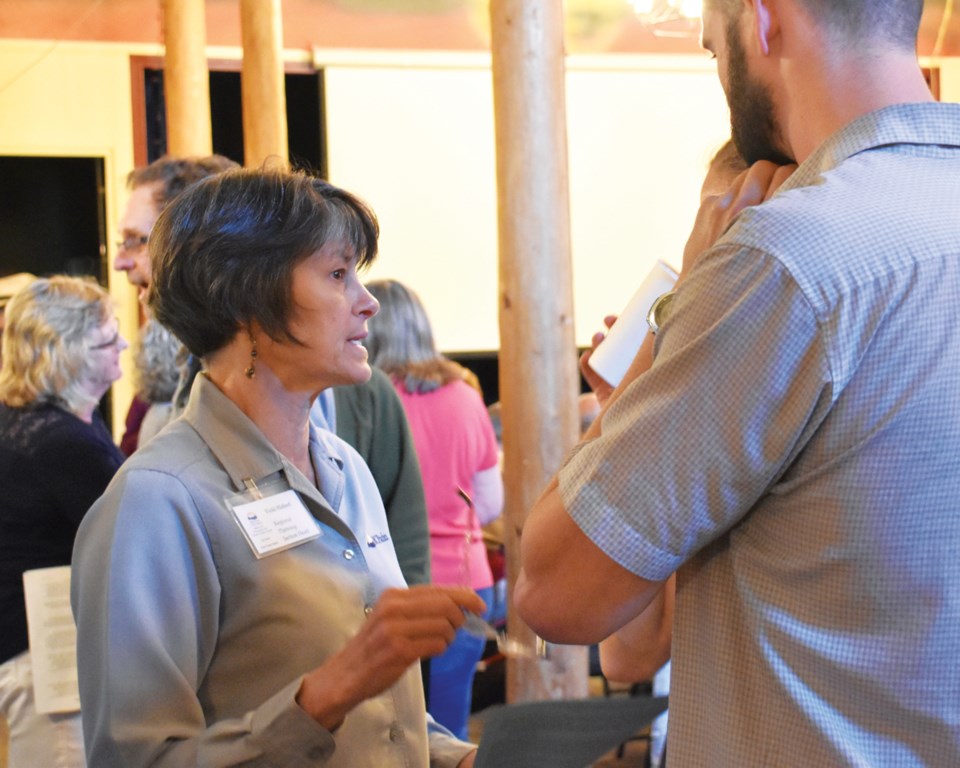More details emerged on the options for redesignating Tetrahedron Provincial Park at the second open house hosted by BC Parks, following public feedback provided at the first.
The open houses form part of the public consultation process required to allow the Sunshine Coast Regional District (SCRD) to build the necessary infrastructure for an additional five-metre drawdown of Chapman Lake.
Initially, BC Parks planned only one open house, but following criticism of the public consultation process, including by Sechelt Mayor Bruce Milne, former Gibsons mayor Barry Janyk and Powell River-Sunshine Coast MLA Nicholas Simons, a second was scheduled.
During the first half of the May 24 event, held at Roberts Creek Hall, BC Parks staff engaged in discussions with attendees at displays scattered around the room. In the second hour, Parks staff answered questions from audience members. Vicki Haberl, head of the regional planning section, Jennie Aikman, regional director, and Tim Janzen, senior parks and protected area planner, formed the panel.
Before questions, Janzen walked the audience through the latest updates and park redesignation options.
The first is to redesignate the park as a protected area, which would allow infrastructure upgrades and maintenance to occur through provisions set out in an Order in Council. Aside from those provisions, Park Act rules would still apply, giving the area protections similar to a Class A park. One detail of the option, which was suggested by a member of the public at the May 2 open house, is that the park could be redesignated as a Class A park after the infrastructure updates are complete.
The second option is the same as the first except rather than the entire park, the redesignation would apply to “the minimum area required to enable improvements to the community water supply.” Janzen said the smaller area is at this point undetermined, though 130 hectares had been suggested, and will be informed by public feedback.
The third option involves redesignating the entire park as a conservancy, managed under the Park Act. Conservancies explicitly recognize the importance of the area for First Nations and have more relaxed provisions allowing for more activities within the park, such as run-of-the-river projects. Logging and mining are not permitted.
BC Parks also acknowledged that several members of the Tetrahedron Advisory Committee and members of the public don’t want to see any changes to the park.
Janzen also said BC Parks “will not support any option that would result in the reduction of the total area under protection.”
Questions from the public focused on how the new designations would affect the park, as well as the perceived detrimental impacts the lake drawdown could have on the surrounding ecosystem.
Aikman said BC Parks has consulted with the Department of Fisheries and Oceans on flow requirements for downstream fish habitat. She also said that a park-use permit would require a monitoring plan to oversee effects and changes to the lake with repeated drawdowns. “We would build provisions also into the permit to take some corrective actions based on the results of that monitoring.”
Aikman said BC Parks would have the authority to stop drawdowns if necessary under the permitting process.
And she said the “additional drawdown would only be triggered when the regional district reached Stage 4 water restrictions,” noting there could be a greater frequency of drought events because of climate change.
Public feedback will be integrated into a summary and recommendation by BC Parks to Environment Minister George Heyman, who will then decide whether to recommend a redesignation of the park, or a portion of it, to cabinet, and then to the legislature, which will have final say. The public consultation process has been extended to June 8. BC Parks staff expect to submit the summary report to Heyman by mid-July.



